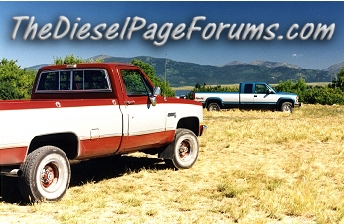
There was another post somewhere that made me rethink marine injectors and Hi-pop's and I thought I would share some thoughts....
It was posted that peak IP/line pressure and injection pulse line pressure was actually much higher than the "pop" pressure of the injectors.
So it dawned on me I have sized pressure cleaning nozzles before and pumps pump a flowrate then you select the nozzle size to build restriction and thus pressure. You have to match them up too big of nozzle and too little flow won't build pressure. Too small of nozzle increases pressure and can choke flow.
So I posted this
Thinking about it further... why the line pressure might exceed cracking pressure is maybe this...
It is kind of sorta like an airplane holding its brakes and reving the engine for a short runway take off. The opening pressure of the injector is also kind of like a mechanical switch so the injection pump won't pee diesel into the cylinder with the wrong time (early) and/or without adequate pressure to produce a good spray pattern.
If the injectors did not have a "pop" pressure the IP would more "slowly" (relatively) build pressure with rotation and pee fuel into the cylinder early then build pressure and spray the middle and last bit. And the combustion time would be all over the place.
In general (really always for positive displacement) pumps pump a flowrate and a nozzle makes the restriction and restriction makes the pressure. (With pumps there generally are relief valves/byapsses etc to control pressure but pumps don't necessarily pump a pressure its a combination of flow and restriction that makes pressure). Without a nozzle the IP would just pee fuel into the cylinder. With a smaller nozzle and more flowrate in a short burst puts higher line pressure and may strain the pump ie hi rpm hi fuel rates.
MAYBE? marine injectors actually may be easier on an IP during hi rpm than you might think even though they POP a little higher. They just open later to insure adequate pressure/flow to produce the desired spray pattern with the bigger orifice in the nozzle.
And this is what makes timing a bit hairy with hi pops/marine injectors with lower flow IP's. You have to match the pop pressure to the orifice size to get good spray then the fuel solenoid closed time has to be timed accordingly so the PCM gets what it expects.
97 5spd K2500 Ext Cab short Bed ~160K miles.
TM, 3" downpipe & 4" exhaust, remote FSD, remote oilfilter, Gauges: EGT, Boost, Fuel Pressure, B&W Gooseneck Turnover ball, Prodigy Brake Controller. Hi-Temp Hydraulic Oil Cooler Lines.









 Reply With Quote
Reply With Quote

 Amsoil Dual Bypass. Baldwin filter. aFe Air filter,
Amsoil Dual Bypass. Baldwin filter. aFe Air filter,

